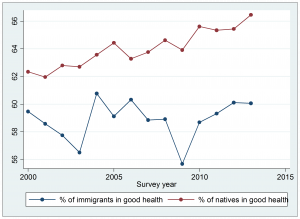Our project explores the link between migration and health. Specifically, we examine the effect of internal migration (the movement of people within their country) on the health of immigrant retirees. There is a growing literature on the health impacts of retirement, but not much work has explored the relationship between movement and health. Atella and Deb (2014) shows that Italian women in poor health showed significant improvements in health from moving from the South of Italy to the North. Stillman, McKenzie, and Gibson (2009) use evidence from a randomized immigration lottery in New Zealand to find that immigrating to a new country has a positive impact on mental health, especially for those in the lower end of the mental health distribution before immigrating. Previous literature seems to suggest that retirement also has a positive impact on health. Most published papers on this topic, including Insler (2014) and Neuman (2008) use instrumental variables to estimate the health impact of retirement. A notable exception to the general trend of the literature, Dave, Rashad, and Spasojevic (2008) suggests that retirement actually has a small negative effect on health.
Building on this previous research, we have used data from the Current Population Survey (CPS) released monthly by the US Census Bureau and the US Bureau of Labor Statistics to investigate the differences between the health of immigrant and native retirees. These two groups differ significantly by a number of characteristics, such as family size, age, and educational attainment. As a result, it is natural to expect that immigrant and native retirees will have different health levels. The graph below shows the portion of immigrant and native retirees who have moved in the past year that report being in good health. This suggests that immigrant retirees are less healthy as a group than natives, though this might be due to demographic differences between the two groups and not merely a result of immigration status.

Similar preliminary research found that stayers were more likely to be in good health than movers, though this might be because many retirees move due to poor health. The small sample size of immigrant movers in the CPS for any given year made it difficult to assess whether moving had a similar negative association with health when comparing immigrant movers and stayers.
It remains unclear whether immigrant and native retirees and movers and stayers vary in health outcomes as a result of their movement status or due to differences in the composition of the groups. Future research will attempt to determine the causal effect of movement on the health of immigrant retirees. We hope to use the Health and Retirement Survey, a dataset which follows the same group of retired individuals over time, to more accurately assess the impacts of movement within a country on health. This dataset will include zip code data that will allow us to get a richer description of the movements of retirees within the US.

